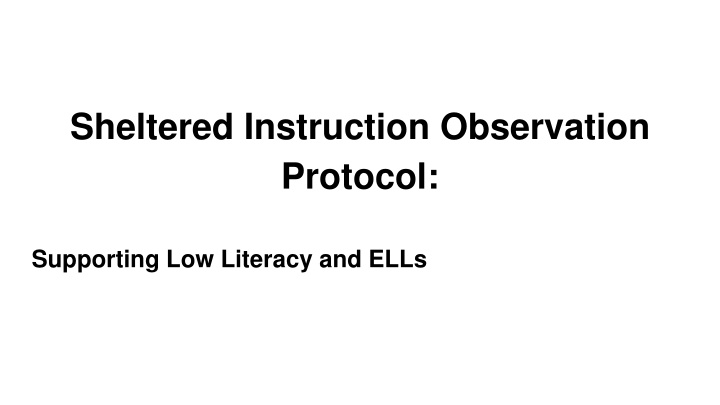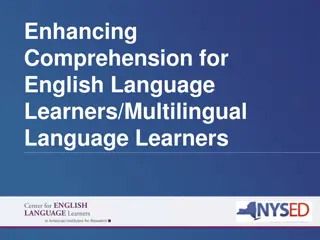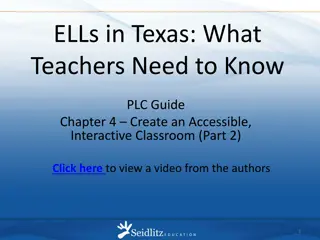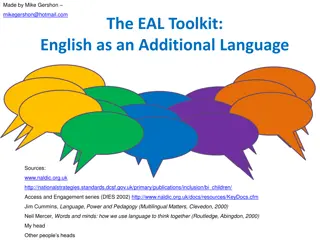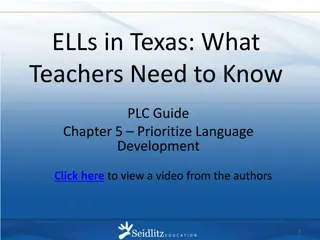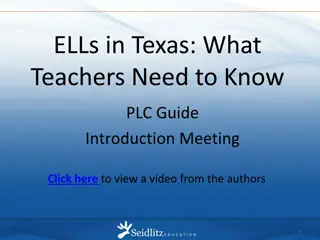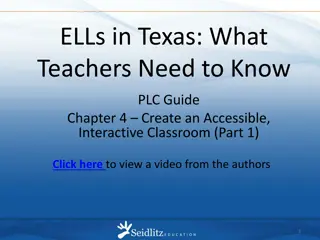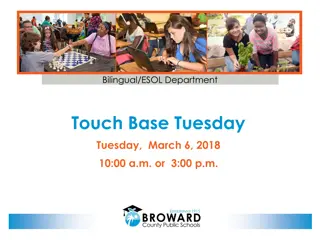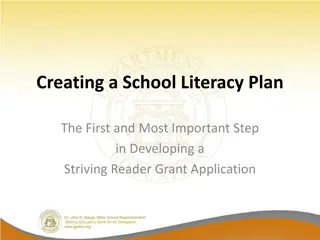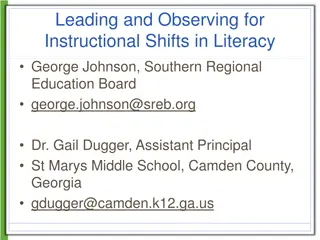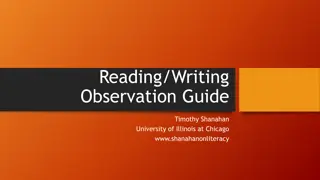Effective Strategies for Supporting Low Literacy and ELLs in Sheltered Instruction
Explore the Sheltered Instruction Observation Protocol (SIOP) with a focus on supporting low literacy levels and English Language Learners (ELLs). Learn about the key components of SIOP, including lesson preparation, building background knowledge, providing comprehensible input, utilizing effective strategies, promoting interaction, facilitating practice and application, delivering lessons, and conducting review and assessment. Discover the importance of building connections to prior knowledge for faster learning and better retention, illustrated with an engaging story of circus trains shaping the evolution of circus performances.
Download Presentation

Please find below an Image/Link to download the presentation.
The content on the website is provided AS IS for your information and personal use only. It may not be sold, licensed, or shared on other websites without obtaining consent from the author.If you encounter any issues during the download, it is possible that the publisher has removed the file from their server.
You are allowed to download the files provided on this website for personal or commercial use, subject to the condition that they are used lawfully. All files are the property of their respective owners.
The content on the website is provided AS IS for your information and personal use only. It may not be sold, licensed, or shared on other websites without obtaining consent from the author.
E N D
Presentation Transcript
Sheltered Instruction Observation Protocol: Supporting Low Literacy and ELLs
SIOP 1) Lesson Preparation 2) Building Background 3) Comprehensible Input 4) Strategies 5) Interaction 6) Practice/Application 7) Lesson Delivery 8) Review and Assessment
Part 1 - - Flip your paper over! Put your pens and pencils down!
Part 1 Flip your paper back over.
The Background Knowledge: https://www.publicdomainpictures.net/pictures/290000/nahled/alphabet-letters-a-z.png
The more connections we can make to prior knowledge, the faster we learn and the faster the information converts to long-term memory.
Picture this: a herd of elephants flies past you at sixty miles per hour, followed by a streak of tigers, a pride of lions, and a bunch of clowns. What do you see? It must be a circus train! One of the first uses of the circus train is credited to W.C. Coup. He partnered with P.T. Barnum in 1871 to expand the reach of their newly combined shows using locomotives. Before circus trains, these operators had to lug around all of their animals, performers, and equipment with a team of more than 600 horses. Since there were no highways, these voyages were rough and took a long time. Circuses would stop at many small towns between the large venues. Performing at many of these small towns was not very profitable. Because of these limitations, circuses could not grow as large as the imaginations of the operators. After they began using circus trains, Barnum and Coup only brought their show to large cities. These performances were much more profitable and the profits went toward creating an even bigger and better circus. Multiple rings were added and the show went on. Today, Ringling Bros. and Barnum and Bailey Circus still rely on the circus train to transport their astounding show, but now they use two.
Background Knowledge Example: - 2 minute trailer.
1) Have you been to the circus? 2) Would you like to go to the circus? 3) How does the circus travel from city to city?
Picture this: a herd of elephants flies past you at sixty miles per hour, followed by a streak of tigers, a pride of lions, and a bunch of clowns. What do you see? It must be a circus train! One of the first uses of the circus train is credited to W.C. Coup. He partnered with P.T. Barnum in 1871 to expand the reach of their newly combined shows using locomotives. Before circus trains, these operators had to lug around all of their animals, performers, and equipment with a team of more than 600 horses. Since there were no highways, these voyages were rough and took a long time. Circuses would stop at many small towns between the large venues. Performing at many of these small towns was not very profitable. Because of these limitations, circuses could not grow as large as the imaginations of the operators. After they began using circus trains, Barnum and Coup only brought their show to large cities. These performances were much more profitable and the profits went toward creating an even bigger and better circus. Multiple rings were added and the show went on. Today, Ringling Bros. and Barnum and Bailey Circus still rely on the circus train to transport their astounding show, but now they use two.
1) What is your favorite type of ice cream? 2) When was the messiest time you ate ice cream?
1) What is your favorite type of ice cream? 2) When was the messiest time you ate ice cream?
Key concepts: 1) Use visuals 2) Personal connection 3) Think vocabulary
SIOP 1) Lesson Preparation 2) Building Background 3) Comprehensible Input 4) Strategies 5) Interaction 6) Practice/Application 7) Lesson Delivery 8) Review and Assessment
List of Activities: Gallery walk 4 corners Fill in the gap A-Z letter boxes Question surveys Strategic partnering
